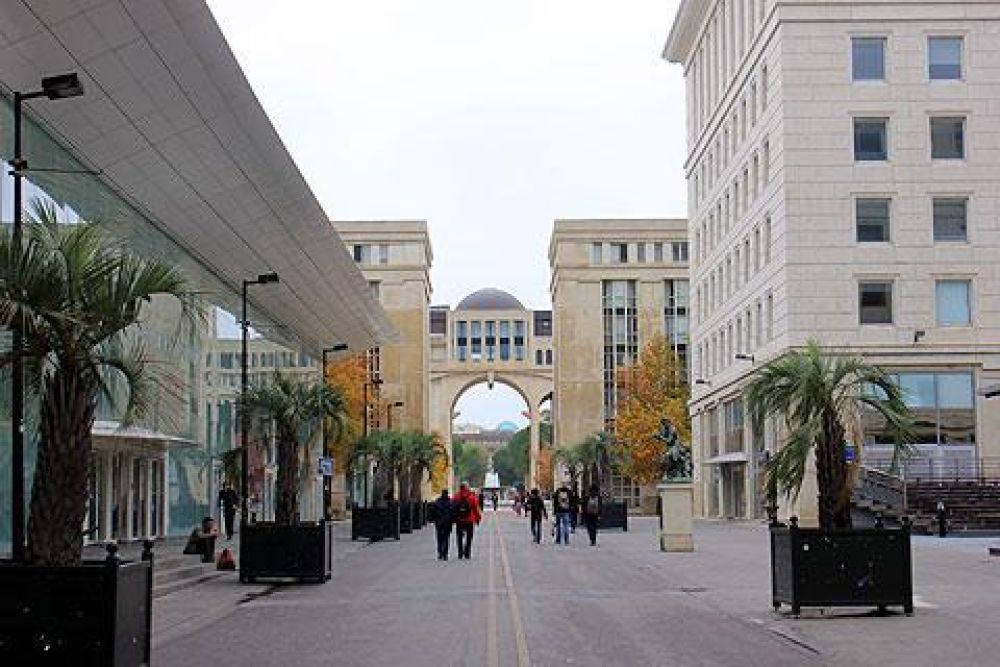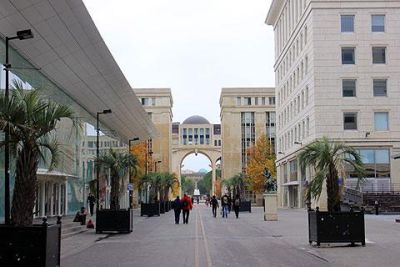

The Fabre Museum holds a significant place in Montpellier's cultural landscape. Established in the historical district of Antigone, the museum boasts a comprehensive collection of European painting ranging from the Renaissance to the modern era. Visitors can marvel at works by famous painters such as Rubens, Delacroix, and Courbet, as well as several paintings by the founder, François-Xavier Fabre. The museum also exhibits sculptures, decorative arts, and temporary exhibitions that shed light on different art movements and art historical periods. The museum's building is a work of art in itself, blending classical architecture with modern touches. A visit to the Fabre Museum not only offers an educational dive into art history but also provides a peaceful retreat surrounded by beauty and creativity.
The Antigone District is a must-see for architecture enthusiasts visiting Montpellier. Designed by Catalan architect Ricardo Bofill in the late 20th century, Antigone is a stunning example of neo-classical architecture blended with modern urban planning. A guided tour here unveils the grandeur of the district’s monumental structures such as the Place de l'Europe, the Esplanade de l'Europe, and the iconic Arc de Triomphe replica - the Porte du Peyrou. As participants walk along the district, they can learn about Bofill's vision for a harmonious urban community, the specific design choices made to craft the district’s aesthetic, and how it has influenced contemporary French architecture. The tour often ends at the River Lez, adding a tranquil natural backdrop to the architectural splendor.
Montpellier's Botanical Garden, or Jardin des Plantes de Montpellier, offers a serene escapade amidst one of the oldest gardens in France. Established in 1593, the garden was initially intended for medical students to study botanical plants. Today, it serves as both a historical and natural haven, featuring a diverse array of plants, trees, and flowers spread over 4.5 hectares. Visitors can wander through the different sections, including the English-style landscaped garden, the systematic garden, and the greenhouse complex. The garden also hosts a variety of events and educational workshops on botany and gardening throughout the year. Its peaceful paths and shaded benches make it the perfect spot for relaxation and reflection, providing a charming contrast to the bustling city life.
The Saint-Clément Aqueduct is an imposing 18th-century structure that served as Montpellier's primary water supply. Today, visitors can explore the history of water management in the city by taking a walk along the towering arches of the aqueduct, starting from the water tower near Peyrou Park and following the path to the ancient water reservoirs at the source. The walk presents not only an opportunity to appreciate the engineering feats of the past but also offers splendid views overlooking Montpellier and its surroundings. Along the way, informative signage and occasionally available guided tours provide in-depth insights into the aqueduct's construction, its role in the city's development, and the broader context of water as a precious resource in urban planning.
Place de la Comédie is the vibrant heart of Montpellier, a bustling square surrounded by historical buildings, outdoor cafes, and elegant shops. Dominated by the impressive Opera Comédie, the square is also known for the iconic Three Graces fountain, which has become a symbol of the city itself. Visitors can join locals and enjoy the Mediterranean climate at one of the many outdoor seating areas while sipping on a coffee or indulging in some local cuisine. Street performers often dot the area, adding to the lively atmosphere with music, dance, or theatrical acts. Place de la Comédie is a must-visit for those wanting to experience the pulse of Montpellier, observe the daily interactions of residents, and perhaps even catch an impromptu market or festival.
The region surrounding Montpellier is renowned for its wine, and no visit is complete without touring a local vineyard. A short drive from Antigone District, visitors can embark on a wine tasting adventure in one of the many estates dotted around the countryside. At these vineyards, seasoned vintners share their passion for winemaking, offering tours that take you through the grape-growing process, the harvest, fermentation, and finally to the aging cellars. The highlight is, of course, the tasting session where guests can savor a selection of reds, whites, and rosés, learning about the specific notes and flavors that characterize the Languedoc wine region. Some tours may also pair wines with local cheeses and other delicacies, rounding out a delightful sensory experience.
For a modern twist on exploring Montpellier, a Segway tour offers an innovative and entertaining way to see the city's highlights. This guided activity ensures you cover more ground than on foot, zipping through the historic streets and along the river banks with ease. After a brief training session on how to operate the Segway, participants follow their guide through areas like Antigone, the historical center, and along the Lez to admire the contemporary architecture and green spaces. It's an ideal activity for families or groups wanting a fun introduction to Montpellier, combining the thrill of riding a Segway with insightful commentary on the city's culture and history.
Odysseum is more than just a shopping center; it's an entertainment complex that offers a wide range of activities, ideal for families and fun-seekers. A short distance from the Antigone District, the center features an aquarium, an ice-skating rink, a planetarium, and several interactive museums, including the Mare Nostrum Aquarium that transports you into the depths of the oceans. For those seeking a thrilling experience, the complex houses an indoor climbing wall and a virtual reality gaming zone. Visitors can spend the day moving from one attraction to the next, taking breaks to enjoy the variety of eateries on-site. With something to entertain every age group, Odysseum represents a modern fusion of leisure, science, and sports under one roof.
Markets are the lifeline of French cities, and Montpellier's outdoor markets present a vibrant tableau of regional produce, crafts, and ready-to-eat treats. A walking tour of these markets provides an immersive experience into the local way of life. Les Arceaux market, held beneath the Saint-Clément Aqueduct, is filled with stalls offering everything from fresh fruits, vegetables, cheeses, meats, to artisanal products and flowers. It's a chance for visitors to practice their French, sample some local flavors, and perhaps pick up a unique souvenir. The market reflects the city's Mediterranean roots, mixing colors, scents, and sounds that create a lively, sensory-rich shopping experience.
The culinary landscape of Montpellier is as diverse as it is delicious. Foodies can delve into the flavors of the south of France by participating in a cooking class. Local chefs and cooking schools offer workshops that teach participants how to prepare traditional French and Mediterranean dishes using fresh, locally-sourced ingredients. From crafting the perfect bouillabaisse to baking traditional French pastries, these classes cater to all skill levels and interests. Not only do participants get hands-on cooking experience, but they also learn about the history and cultural significance of the dishes they create. At the end of the class, everyone gathers to enjoy the fruits of their labor—a convivial dining experience that combines learning, cooking, and eating.
